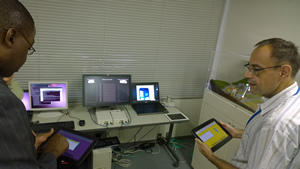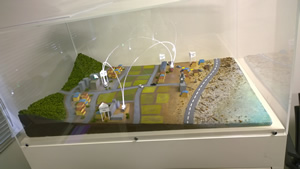
| DSA Newsletter | Q3 2014 | www.dynamicspectrumalliance.org | events, future plans, news and more |
|
||||||
| Keeping you updated about our activities! Here we highlight our latest work and focus on areas where we are empowering the next wave of spectrum access. | |||
| As Executive Director, I can hardly overstate how much cooperation is key for the Dynamic Spectrum Alliance as we continue to build relationships and work with regulatory bodies around the world, advocating for laws and regulations that will lead to more efficient and effective spectrum utilisation. The ITU is a key plank to such cooperation, and I am truly honoured that the Alliance is now officially an ITU-D sector member. Joining ITU-D, which aims to nurture international cooperation and solidarity in the creation, development and improvement of telecommunication networks in developing countries, comes as we continue to promote regulatory policies which will pave the way for innovative wireless technologies across the world. As an ITU-D member, we have already started participating, and will continue to participate in the ITU-D Study Groups to promote effective and efficient spectrum management and to promote geo-location as best practice on the opportunistic use of TVWS spectrum - as has already been permitted in the USA and Singapore, and soon to be in other countries including the UK, Malawi, South Africa, etc. Indeed, geo-location as a spectrum access system (i.e. incorporating a geo-location enabled dynamic database to help govern dynamic spectrum allocation and authorization) can also be used to govern access in other bands. For example, the FCC in the USA has proposed just such a spectrum access system to govern access to the 3.5 GHz Band in its 3.5 GHz Proposal (GN Docket No. 12-354) of December 2012. Others like the University of Berkeley have proposed geo-location for GSM bands leading to the concept of GSM whitespaces. So geo-location is not just about the TV bands or TVWS. It is about accessing spectrum in a dynamic way, i.e. dynamic spectrum access. Working within the ITU, we hope to make leaps in setting dynamic and opportunistic spectrum access regulations across the globe, encouraging opportunistic spectrum access pilot project initiatives, and ultimately facilitating new players who would usher in new competition, business models and innovations in order to connect the next 3+ Billion broadband-unconnected, thereby closing the digital divide. | |||
| Globally, we have worked with other regulators and just recently I toured Asia, where the pace of development is incredible. The trip saw me meet with high-level representatives from regional organisations, regulatory bodies and Governmental departments that are propelling the region forward particularly in China and Japan. My thanks go to Alliance members, Jeffrey Yan, Director of Technology Policy at Microsoft, Shih Mo, CEO and President of Aviacomm, Hiroshi Harada, Executive Research Director at NICT and EJ Chiang Director of Business Development at MediaTek, who made many of the introductions and supported me while I was there. Below are some highlights only. | |||
| China Telecom Beijing Research Institute – China Telecom is the largest fixed-line service and the third largest mobile telecommunication provider in mainland China, so it was fantastic to meet with them as a highly respected organisation and potential new member of our Alliance. We met the Director of the Smart City Division, Jiang Hongyuan and his team to discuss advocacy for dynamic spectrum access and how the Alliance is driving exciting new activities forward. | |||
CATR (China Academy of Telecommunication Research of MIIT) – Since its formation in the mid-1950s, CATR has undertaken a great deal of major telecommunications 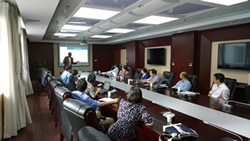 research for the country and the industry. It has therefore accumulated rich experience in communications policies, standards for telecommunication technologies, planning of communications development, and product testing and certification, making great contributions to the development of the communications industry in China. It is a real think tank and while there I delivered a presentation on the Alliance and we met with Professor Wan Yi, Director of Radio and Mobile Communications Department and Li Shan, New Technology and New Services Deputy Director. This meeting was incredibly successful with representation from high-profile companies such as Huawei and NEC. research for the country and the industry. It has therefore accumulated rich experience in communications policies, standards for telecommunication technologies, planning of communications development, and product testing and certification, making great contributions to the development of the communications industry in China. It is a real think tank and while there I delivered a presentation on the Alliance and we met with Professor Wan Yi, Director of Radio and Mobile Communications Department and Li Shan, New Technology and New Services Deputy Director. This meeting was incredibly successful with representation from high-profile companies such as Huawei and NEC. |
|||
 SARFT (State Administration of press, publication, Radio, Film and Television of the People's Republic of China) – SARFT falls under the direct supervision of the State Council and is in charge of the country's radio, television and film industry, directly supervising China National Radio, China Radio International and China Central television. We met with Wang Xiaojie, Director General and Zhou Xinquan, Director of Terrestrial Division, who is responsible for the roll-out of 90,000 transmission base-stations across China. DSA members may start working with SARFT as a result of this visit. SARFT (State Administration of press, publication, Radio, Film and Television of the People's Republic of China) – SARFT falls under the direct supervision of the State Council and is in charge of the country's radio, television and film industry, directly supervising China National Radio, China Radio International and China Central television. We met with Wang Xiaojie, Director General and Zhou Xinquan, Director of Terrestrial Division, who is responsible for the roll-out of 90,000 transmission base-stations across China. DSA members may start working with SARFT as a result of this visit. |
|||
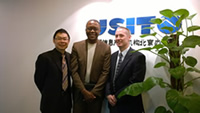 USITO (United States Information Technology Office) – Founded in 1994, USITO seeks to provide new insights and approaches to the many complex challenges facing the ICT industry in China, which sits at the heart of the U.S.-China trade relationship. We met with Matt Roberts, Managing Director, who kindly hosted a gathering of local companies to introduce them to the Alliance and encouraged them to become members. Companies included Broadcom (now a member), Motorola, Huawei, NEC and other local Chinese firms. USITO (United States Information Technology Office) – Founded in 1994, USITO seeks to provide new insights and approaches to the many complex challenges facing the ICT industry in China, which sits at the heart of the U.S.-China trade relationship. We met with Matt Roberts, Managing Director, who kindly hosted a gathering of local companies to introduce them to the Alliance and encouraged them to become members. Companies included Broadcom (now a member), Motorola, Huawei, NEC and other local Chinese firms. |
|||
 Ministry of Internal Affairs and Communication (MIC), Japan – the Ministry is a cabinet-level bureau of the Government of Japan. We met with Yasuo Tawara, Director of Radio Policy Telecommunications Bureau Division, his deputy Ogawa Kuniko and his engineers to discuss dynamic spectrum access in the region. It was a truly positive meeting (scheduled for 1 hour but went on for 2 hours) in which I took many questions about my dynamic spectrum access experiences at Ofcom. Ministry of Internal Affairs and Communication (MIC), Japan – the Ministry is a cabinet-level bureau of the Government of Japan. We met with Yasuo Tawara, Director of Radio Policy Telecommunications Bureau Division, his deputy Ogawa Kuniko and his engineers to discuss dynamic spectrum access in the region. It was a truly positive meeting (scheduled for 1 hour but went on for 2 hours) in which I took many questions about my dynamic spectrum access experiences at Ofcom. |
|||
| Microsoft Japan – We had a very successful meeting with Shunichi Kajisa, CTO of Microsoft Japan, Ken Tamaru, National Technology Office Director and Ken Ketaya, Deputy Director of Legal and Corporate Affairs. | |||
| Toyota InfoTechnology Center – While we were in the region, we dropped into to visit Alliance member, Toyota ITC. There we saw several demos of how the company is involved in numerous TVWS projects across Japan. | |||
|
|||
| It’s also worth mentioning that we also met up with many other companies and organisations in Asia, including Baidu, the search engine of choice for 85 per cent of China's Internet users, SRRC and the National Economy Prosperity Investment Company’s Executive General Manager, Xu Yan and his assistant Tan Ping. We also met with the China Center for International Economic Exchanges (CCIEE), which provides central and local Governments with analysis reports and policy proposals on macroeconomic management, medium and long-term development planning, and vital economic policies. | |||
| Looking ahead, plans are underway for the next Dynamic Spectrum Alliance Global Summit, which we intend to hold in Asia in April or May, 2015. We hope to build on the success of last year’s Summit, which was co-hosted by the National Communications Authority of Ghana, and attracted good support from both the industry and the region, including forward-thinking regulators, leading academics, cutting-edge technologists and pioneering business figures. We’re still yet to confirm the location of 2015’s Summit, so I urge anyone who would like be involved, and who would like to host with us, to get in touch. | |||
| So over the last quarter, we have joined and participated in an ITU-D study group, and hosted a workshop courtesy of Google in Nairobi (Kenya) wherein regulators from sixteen countries truly got to understand TVWS regulations and technology up close. They elected several countries amongst themselves led by Egypt (and other countries like Malawi and Kenya who have concluded trials) to do a report on TVWS for developing economies which I will like to see as in input into ITU-D. We advocated successfully in SADC in Malawi. Nigeria, the most populous African country and largest by GDP too, issued several TVWS trial licenses. I visited and saw a pilot of a tri-band WiFi radio (2.4Ghz, 5Ghz and TV bands) using 802.11af at the University Strathclyde, Scotland. China’s SARFT is keen on engaging DSA members on TVWS bands. Japan’s MIC appears willing to engage dynamic spectrum access in earnest and TVWS, and a Japan DSA branch may just emerge in order to facilitate this. New members have joined DSA. And I am massively excited about the prospects of 802.11af, a WiFi variant operating in the white spaces of the TV bands, and which MediaTek has announced will deliver chipsets in 2015, ushering in TVWS dongles, tri-band devices and 802.11af chipsets in DSO set top boxes. The Regulatory Affairs workgroup led by Aparna Sridhar (Google representative on our Board) has just concluded work on a model set of TVWS rules endorsed by the DSA Board which Board members and I will start advocating for shortly. | |||
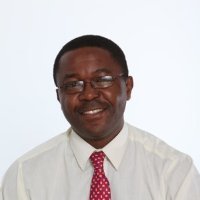 |
So real technological developments, like 802.11af, re-enforce our regulatory advocacy efforts, which in turn feed into further technology and standardization efforts. Would you blame me for thinking we are moving the regulatory needle. Thank you for your continued support! Prof. H Nwana, Executive Director |
||
| Regulatory Affairs Work Group drives policy forward | |
| Our Regulatory Affairs Work Group, which was formed in November 2013, continues to develop policy positions for ratification by the Dynamic Spectrum Alliance. The Group’s role sees participants draft documents for submission to regulatory agencies while developing higher-level positions on critical issues related to dynamic spectrum sharing. | |
| Since its formation, the Work Group, which is co-chaired by Aparna Sridhar (Google) and Angelo Cuffaro (InterDigital), has submitted responses to numerous consultations in a variety of jurisdictions. The goal of these submissions has been to advance policies that enable dynamic spectrum sharing and additional access to spectrum for license-exempt use. This includes the recent submissions to Ofcom on the future use of the 700 MHz Band and to the Communications Regulatory Authority’s consultation on future spectrum demand in Qatar. A full list of the submissions is available here. | |
| The Work Group supports sharing both among Governmental and non-Governmental users and among different types of commercial users. Another overlapping area of focus is increasing access to spectrum for license-exempt use. There are very few barriers to entry for innovators and entrepreneurs who want to make use of license-exempt frequencies; as a result, these frequency bands tend to be a hot-bed of innovation and experimentation. As such, enabling unlicensed use in high, medium, and low bands is likely to foster new technical developments in wireless technologies and corresponding economic growth. | |
| Looking to the next quarter, the Work Group will continue to advance these priorities by focusing on demonstrating the social and economic benefits that spectrum sharing and unlicensed access can provide, across a variety of sectors. | |
| Any Dynamic Spectrum Alliance member can participate in the Regulatory Affairs Work Group, so if you are interested in this area, then please contact admin@dynamicspectrumalliance.org. Likewise, if anyone would like to harmonize their regulatory rules with the Alliance, then please contact admin@dynamicspectrumalliance.org. | |
| Model rules for TVWS | |
| Under the expert leadership of Aparna Sridhar, the Regulatory Affairs (RA) Work Group has - over the last 3 months - designed/evolved a model set of rules and regulations for the use of TV white spaces. H Nwana is particularly proud of this achievement of the RA Work Group because the idea of producing such a set of model rules and regulations was one of the key actions that emerged from regulators and policy makers at the Accra, Ghana Global Summit in May. The suggested rules would help and guide regulators to define their own TVWS rules and regulations as well as help facilitate harmonisation of regulations, which in turn would drive economies of scale of both base station equipment, CPE devices as well as geo-location databases. Indeed MACRA, the regulator in Malawi, has already made use of these rules in the making of their TVWS regulations." | |
| The Dynamic Spectrum Alliance is therefore pleased to announce that the Model Rules and Regulations for the use of Television White Spaces, drafted by the DSA Regulatory Affairs Work Group and approved by the Board of Directors, are now published on the DSA website. In addition to the Model Rules, there is a background document and FAQ to help provide context around the rules. | |
| The Alliance is extremely excited to have these Model Rules in place that are designed to be a template on which to base rules for license-exempt use of TV White Spaces. They include provisions that provide a technical framework to enable license-exempt access to valuable, underutilized spectrum while protecting incumbent licensees. | |
| Executive Director, H Nwana, and other Board members will heavily promote these Model Rules as they continue to engage with regulators and government officials around the world. | |
| New Members |
| We’d like to welcome our new members: Aruba (Europe) Limited, ATDI and Broadcom. We look forward to working closely with our new members and welcome their expertise and innovative ideas as we look to solve the spectrum crunch. |
| The Dynamic Spectrum Alliance welcomes interested companies to join, so please visit our membership page, which provides a membership level breakdown. |
| Spotlight on.....Europe and North America | |
| New report from the European Commission | |
| The European Commission has recently published its Report to the European Parliament and the Council on the Spectrum Inventory. The report's main objective is to present the state of play concerning collection of data from the Member States, the current results of the analysis in terms of spectrum demand and supply and key findings as to how these results could be transformed into more efficient use of spectrum. | |
| The key findings in the report could lead to actions during the coming years, including potential Commission proposals concerning harmonised technical conditions for spectrum use across Europe. As a stakeholder in the area of spectrum, the European Commission has welcomed feedback from the Alliance on these key findings. They are also interested in factual information regarding existing spectrum use, in order to further substantiate the data collected through the inventory process. Please send any feedback or comments you may have on this report to the email address CNECT-B4@ec.europa.eu by the 31 October 2014. | |
| GLN challenges public libraries to use TVWS | |
Gigabit Libraries Networks (GLN), the open global collaboration of tech-savvy libraries cooperating as a distributed test bed and showcase environment for high performance applications and equipment in the service of educational, civic and cultural objectives, has submitted its proposal for the first round under the Knight Challenge related to Access. This project will see libraries deploying TVWS pilot networks in every state across the US to foster innovative uses of a new license-free, regional-scale wireless broadband capability. Using low cost TVWS equipment, potentially any library facility can deploy multiple new remote library Wi-Fi access points at convenient fixed locations, OR as movable (nomadic fixed) hotspots supporting civic/cultural activities, OR as on-site disaster response ICT resources, OR to develop a hub for entrepreneurs at collaborative work spaces or other venues, OR... |
|
TVWS, using vacant TV frequencies opened by the FCC, enable long range non-line-of-sight data communications of particular value in un/underserved rural areas. With eight states already committed, GNL has proposed small direct grants to any state library office agreeing to request and process in-state proposals, then using those funds to support 2+ TVWS projects. |
|
GLN, already making significant progress in connecting the unconnected in remote, undeserved and rural areas, has developed a new interactive prospective coverage map, highlighting where remote hotspots might be deployed and supported from one or more of 16,000 libraries with TVWS base stations. |
|
| World’s first tri-band Wi-Fi transceivers hosted in the Glasgow White Spaces Pilot, UK | |
| With strong support from the Scottish Government, Microsoft, Mediatek, 6Harmonics, Aviacomm, Sky and the University of Strathclyde have successfully cooperated in trialling the world’s first triple band Wi-Fi transceivers. The inclusion of TV white spaces (TVWS) (in compliance with the latest IEEE 802.11af standard), alongside the standard 2.4 and 5 GHz bands heralds a great step forward in the development of the world’s most popular wireless network technology. |
|
| Hosted by the Centre for White Space Communications (CWSC), within the University of Strathclyde, the collaboration stemmed from discussions on global market opportunities and strong industry interest in Ofcom’s ongoing UK TVWS pilot. The groundbreaking technology was flown to Glasgow accompanied by a team of engineers from Mediatek and 6Harmonics, who worked alongside CWSC researchers to maximize the value of the equipment’s first ever over-air tests. |
|
| The significance of tri-band Wi-Fi transceivers is great – for instance, conventional Wi-Fi transceivers offer limited coverage in comparison and are severely curtailed by walls of buildings. The inclusion of the TVWS band in the tri-band unit enables coverage to be much broader and more reliable, both indoors and outdoors. To find out more about the power of white spaces technology, view BBC Newsnight’s story here. | 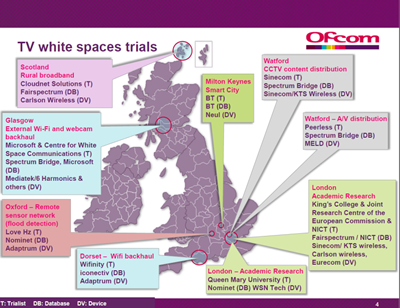 |
| White space trials in the UK underway | |
| White space technology is now being piloted in the UK, which is the first of its kind in Europe. From rural broadband trials in the Orkney Islands, right down to Wi-Fi backhaul trials in Dorset, Ofcom aims to test all interactions between devices and databases in order to develop a proposed framework. A number of companies are taking part in the trials, some from as far away as Japan. |
|
| Community Broadband Award for City of Wilmington and New Hanover | |
| The City of Wilmington and New Hanover County, NC were presented the ‘Community Broadband Wireless Network of the Year’ Award by the National Association of Telecommunications Officers and Advisors (NATOA) Community Broadband Awards. Working with 6Harmonics the first TVWS network of its kind was deployed in 2012 and successfully delivered wireless broadband to dispersed remote locations, as well as providing broadband access to the New Hanover County Juvenile Centre, police stations and the Youth Enrichment Zone. The TVWS network has proved particularly valuable to manufacturers and serves as a test-bed for new radio devices. | |
| Elsewhere in the world….. |
| True broadband speeds for Ghana |
| Earlier this year, another TVWS pilot was launched in Ghana, joining the growing list of pilots across the continent. SpectraLink Wireless, with help from Alliance members Facebook and Microsoft, rolled out broadband using TVWS across the campuses at All Nations College and Koforidua Polytechnic. Using SpectraLink equipment, the pilot is part of Microsoft’s 4Afrika Initiative, which aims to improve the region’s competitive positioning by facilitating technology access, while ensuring students have reliable Internet access as true broadband speeds. |
| Nigeria makes leaps with TVWS trials |
| As Nigeria continues to take steps in the TV digital switchover from analogue TV, it has also approved several year-long TVWS projects by issuing provisional approvals “of the grant of TVWS Pilot licenses”, including to several Alliance members. |
| The country’s Ministry of Communications (MoCT), NCC (Nigerian Communications Commission) and NBC (National Broadcasting Commission) have already set up a committee to consider the needs and modalities for TVWS trials in Nigeria. The newly formed committee submitted a TVWS report to the National Frequency Council, where it was endorsed and as a result the trials will be regulated and supervised by the MoCT, NCC and NBC. The committee will also guide the development of a regulatory framework for TVWS adoption and deployments across Nigeria. DSA advocacy has been instrumental in making these trials happen. |
| Namibia sees largest TVWS project of its kind |
| MyDigitalBridge Foundation in partnership with Microsoft and Adaptrum, with support from the Millennium Challenge Corporation (MCC) and Millennium Challenge Account (MCA)-Namibia, has successfully trialled the Namibian TV White Spaces (TVWS) pilot project. The intention is to provide a blueprint of broadband internet connectivity countrywide. Called ‘Citizen Connect’, the pilot consists of a network deployed over a 62km x 152km (9,424 km²) area covering three regional councils: Oshana, Ohangwena and Omusati, and connecting 28 schools in northern Namibia. This makes it the biggest TVWS project of its kind in terms of area coverage. |
| “This pilot project came at the right time for us to answer to the challenges of internet access, or the lack thereof, to all our citizens. This pilot project is ambitious by any standard and can only be realised with the support and contributions from a large stakeholder community. |
| I call on all stakeholders to continue to collaborate in an effort to ensure that we afford all Namibians the right of internet access for purposes of education, health and government services,” says Hon. Dr. Moses Amweelo, the Chairman of the Parliamentary Standing Committee on ICT. |
| Malawi TVWS rules nears finalization |
| Malawi’s regulator MACRA is in the process of finalising its TVWS rules, and is set to be the first African country to do so. MACRA has worked closely and taken feedback from DSA in the formulation of its rules, indeed they suspended their work to ensure they engaged with the Alliance who was also in the process of developing its model rules. We believe Malawi’s efforts to “harmonise” its evolving TVWS rules and regulations along with the Alliance’s recommendations would ultimately drive more economies of scale in TVWS devices and equipment deployed in Malawi. This is good news for Malawians and we encourage other countries to work with the Alliance as Malawi is doing on their own rules. |
| Recent Industry Events |
| Super Wifi Summit: The Global Spectrum Sharing and TV White Space Event, 12-14 August, Las Vegas, USA The Dynamic Spectrum Alliance was an Associate Partner of this event, which gave attendees an understanding of White Space spectrum and its true potential, as well as the business and technical issues involved. Paul Garnett (Microsoft) joined the agenda on behalf of the Alliance, where he shared his experience with shared spectrum strategies with other innovators from around the world. CRASA TVWS Workshop,14-16 August, Malawi, Africa H Nwana was invited to speak at this workshop, where he shared his experience of TVWS and Dynamic Spectrum Access: from spectrum policy to draft TVWS rules. This talk started with the Alliance’s core purposes, the role of good spectrum policy (and dynamic spectrum policy) to achieve these core purposes and how these latter two lead to the DSA’s proposal that geographical/geo-location databases are a state-of-the-art “best practice” which regulators would depend on. ATU’s 2nd African Spectrum Working Group meeting, 26-28 August, Nairobi, Kenya H Nwana attended this workshop that attracted no less than 16 regulators, including those from Kenya, Tanzania, Cameroon, Chad, Benin, Zimbabwe, Mozambique, Zambia, Burundi, Botswana, Equatorial Guinea and Uganda. The event attracted over 100 participants and while there, H Nwana delivered three presentations including one focused on ‘TVWS and Dynamic Spectrum Access: from spectrum policy to draft TVWS rules’. Other speakers included Anno Hart from TENET, who spoke about South African TVWS trials. On day three of the meeting, delegates voted in favour of a motion to accept the proposal for the ATU to conduct a holistic Study into introducing TVWS in Africa. IBC,12-16 September, Amsterdam 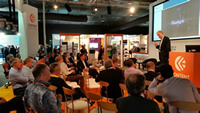 At IBC 2014 Jim Beveridge (Microsoft) spoke on the panel entitled “Spectrum squeeze and the battle for bandwidth”. IBC is attended by more than 50,000 industry professionals from 170 countries and consequently the event provides a fantastic international platform for the Alliance to gain exposure. If you were unable to attend IBC, or would like to relive the event you can watch the panel session here. Jim Beveridge also participated in an interview with Total Telecom on behalf of Dynamic Spectrum Alliance. The footage from the interview can be seen here. At IBC 2014 Jim Beveridge (Microsoft) spoke on the panel entitled “Spectrum squeeze and the battle for bandwidth”. IBC is attended by more than 50,000 industry professionals from 170 countries and consequently the event provides a fantastic international platform for the Alliance to gain exposure. If you were unable to attend IBC, or would like to relive the event you can watch the panel session here. Jim Beveridge also participated in an interview with Total Telecom on behalf of Dynamic Spectrum Alliance. The footage from the interview can be seen here.
NigeriaCom,16-17 September, Victoria Island, Nigeria Ken Spann (WaveTek) joined a panel that explored spectrum as the key enabler for digital Nigeria. He was joined by attorney Ayo Oke, former Special Advisor to the Minister of Communications Technology, an NCC regulator and Olusegun, head of Transmission Planning. Read H Nwana’s blog about TVWS in Nigeria: http://nigeria.comworldseries.com/tv-white-space-in-nigeria/. Radio Spectrum Technology & Management Conference @ Wireless China Industry Summit,17-18 September, Beijing, China The Alliance held a heavy presence at this event with H Nwana and EJ Chiang (Mediatek) both presenting. EJ spoke on the opening day about utilising spectrum’s full potential, highlighting the benefits of geo-location databases, Alliance members’ pilot projects and how the spectrum shortage will hamper the Wi-Fi industry. H Nwana also led a session entitled “DSA’s time has come” on the following day. This session promoted the need for effective and efficient spectrum management while stressing the importance of Dynamic Spectrum Alliance. |
| Upcoming Industry Events |
| The 2nd Annual Internet of Things Global Summit, 27-28 October, Washington DC, USA NICC Open Forum, 12 November, London, United Kingdom The Americas Spectrum Management Conference, 12-13 November, Washington DC, USA ANE Annual Spectrum Conference, 25-27 November, Columbia ITU Telecom World 2014, 7- 11 December, Doha, Qatar |
Get in touch |
|
| If you would like more information, or if your company or organization is interested in joining the Dynamic Spectrum Alliance, then please email | |
| admin@dynamicspectrumalliance.org | |
| Alternatively, visit our membership page, which provides a membership level breakdown. | |
Follow Us |
|
   |
